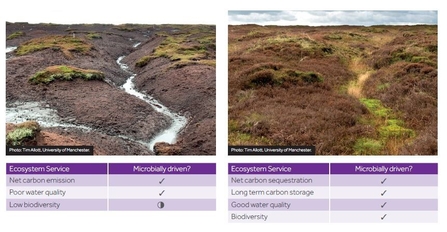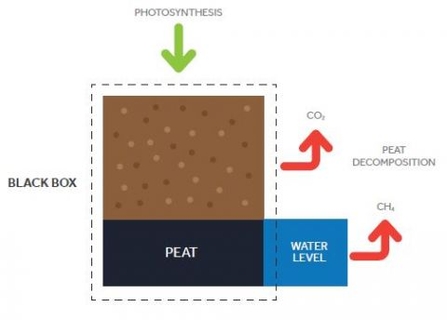
Pre and post restoration of a peatland gully. Credit Tim Alott / University of Manchester

Pre and post restoration of a peatland gully. Credit Tim Alott / University of Manchester
Martin Evans, Clare Robinson, Danielle Alderson, Jonathan Ritson (University of Manchester)
We know that fundamentally carbon cycling in peatlands is driven by the microbiome, the billions of bacteria, fungi and archaea that live in peat. However, despite advances in peatland science and restoration practice, we do not yet have a process-based understanding of how the microbiome controls peatland resilience and carbon sequestration.
To advance this area, we hosted a series of workshops at the University of Manchester in 2019/20, bringing together peatland scientists, practitioners, NGOs and government departments. The aim of the workshops was to capture the state of the art in microbial understanding of peatland functioning, and to define a research agenda to push this area forward. At the end of the workshops, attendees voted on a series a research questions to prioritise future experimental and modelling efforts.
The workshop attendees agreed that to develop our knowledge and aid peatland restoration practice, we first need to be able to characterise peatland microbial communities under different conditions and recognise what a ‘good’ community looks like. This could open the door to microbial monitoring tools to streamline indication of restoration success and recommend future management actions. In the longer term, there is potential to use the outcomes of monitoring to guide interventions designed to restore microbially-driven functions more rapidly and reliably compared to the passive approaches presently employed. To do this investment is needed now in research delivered through existing restoration projects, to unravel the microbial ‘black box’ and understand how peatland type, management and condition alter the microbial community and its functioning.

Illustration of peatland 'black box'. Credit University of Manchester
A key part to how we can further this research agenda is to increase collaboration between academics and practitioners, as well as ensuring that experimental work is designed with the modelling and remote sensing community in mind. Current models based on proxies for microbial activity, such as water table and temperature, work under present conditions, however we do not know how they will perform if climate or land management changes produce no-analogue conditions.
To find out more about the project visit the Peatland Microbiology website where the outcomes of the series of workshops involving peatland scientists, microbial ecologists, practitioners, land managers, NGOs and government departments can be found, as well as a policy brief and academic papers published during the project. This work was funded as part of the UK NERC climate resilience programme.